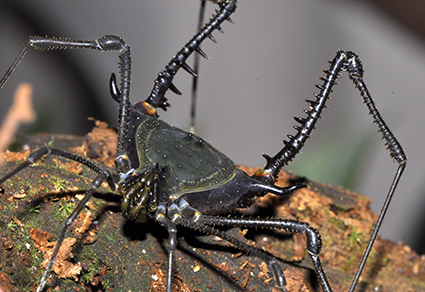Abstract
In this study, we utilize microCT scan technology to investigate the morphology of femur IV in a new species of the genus Cajango, a member of the clade K92 of Gonyleptidae. The femur IV in males of K92 is often characterized by heavy spiniform apophyses arranged in longitudinal rows, referred to as armature. We discuss the potential of this technique to enhance future phylogenetic analyses by providing additional morphological characters. Cajango ednardoi sp. nov. is described from the Biological Reserve of Mata Escura, situated in the middle course of the Jequitinhonha River in eastern Brazil. This reserve falls within WWF Ecoregion NT0104 (Bahia interior forests). The genus Cajango already includes three other species, all of which are found along the northern bank of the Jequitinhonha River, but considerably closer to the coast in Bahia state, within NT0103 (Bahia coastal forests). The discovery of the new species extends the combined range of the genus further westward, marking its first recorded occurrence within the state of Minas Gerais. Additionally, it appears to be restricted to altitudes between 750 and 1100 meters, whereas most records of the other three species are from altitudes below 600 meters. The new species is most similar in general appearance to Cajango pestifer Kury & Bernabé, 2023. However, the armature of the male femur IV is more profuse, and the male genitalia do not share the extremely elongated ventral plate with deep cleft found in all other Cajango species. This suggests that the new species may represent the earliest branch of the genus, standing as the sister-group to all others, which, in turn, share slender femur IV and specialized genitalia.
References
- de Ázara, L.N. & Kury, A.B. (2019) The mosaic tiled harvestmen – taxonomic review of Gonyleptellus (Opiliones: Gonyleptidae: Gonyleptinae). Zootaxa, 4623 (2), 201–238. https://doi.org/10.11646/zootaxa.4623.2.1
- Buzatto, B.A., & Machado, G. (2014). Male dimorphism and alternative reproductive tactics in harvestmen (Arachnida: Opiliones). Behavioural Processes, 109 (Part A), 2–13. https://doi.org/10.1016/j.beproc.2014.06.008
- DaSilva, M.B. & Gnaspini, P. (2010) A systematic revision of Goniosomatinae (Arachnida : Opiliones : Gonyleptidae), with a cladistic analysis and biogeographical notes. Invertebrate Systematics, 23 (6), 530–624. [2009] https://doi.org/10.1071/is09022
- DaSilva, M.B., Pinto-da-Rocha, R. & DeSouza, A.M. (2015) A protocol for the delimitation of areas of endemism and the historical regionalization of the Brazilian Atlantic Rain Forest using harvestmen distribution data. Cladistics, 31, 692–705.
- DaSilva, M.B., Pinto-da-Rocha, R. & Morrone, J.J. (2017). Historical relationships of areas of endemism of the Brazilian Atlantic rain forest: A cladistic biogeographic analysis of harvestman taxa. Current Zoology, 63 (5), 525-535.
- García, A.F. & Kury, A.B. (2017) Taxonomic revision of the Andean harvestman genus Rhaucus Simon, 1879 (Arachnida, Opiliones, Cosmetidae). Zootaxa, 4338 (3), 401–440. https://doi.org/10.11646/zootaxa.4338.3.1
- Hara, M.R., Bragagnolo, C. & Pinto-da-Rocha, R. (2017) Revision of Thaumatocranaus Roewer, 1932, with description of two new species (Opiliones: Laniatores: Gonyleptoidea). Zootaxa, 4254 (4), 457–472. https://doi.org/10.11646/zootaxa.4254.4.3
- Kury, A.B. (2014) Why does the Tricommatinae position bounce so much within Laniatores? A cladistic analysis, with description of a new family of Gonyleptoidea (Opiliones, Laniatores). Zoological Journal of the Linnean Society, 172 (1), 1–48. https://doi.org/10.1111/zoj.12165
- Kury, A.B. & Bernabé, T.N. (2023) Description of two new genera and five new species of clade K92 from Bahia and Espírito Santo, southeastern Brazil (Arachnida, Opiliones, Gonyleptidae). Zootaxa, 5351 (4), 401–434. https://doi.org/10.11646/zootaxa.5351.4.1
- Kury, A.B., Bernabé, T.N., de Ázara, L.N., Araujo, D.C. & Benedetti, A.R. (2022) Phylogeny of the clade K92 (Opiliones, Laniatores, Gonyleptidae) with description of a new subfamily and discussion on the evolution of caelopygine facies and sexual dimorphism. Zoologischer Anzeiger, 298, 70–122. https://doi.org/10.1016/j.jcz.2022.03.004
- Kury, A.B. & Mendes, A.C. (2024) Deviant unicorns: monocerate and dicerate versions of Carlotta Roewer, 1943 (Opiliones: Gonyleptidae), with description of four new species from Eastern Brazil. Austral Entomology, 63 (2), 175–209. https://doi.org/10.1111/aen.12683
- Kury, A.B., Mendes, A.C., Cardoso, L., Kury, M.S., Granado, A.de A. Giribet, G., Cruz-López J.A., Longhorn, S.J., Medrano, M., Oliveira, A.B.R. de, Kury, I.S. & Souza-Kury, M.A. (2023) World Catalogue of Opiliones. WCO-Lite version 2.6. Available from: https://wcolite.com/ (date accessed)
- Medrano, M.A., Kury, A.B. & Mendes, A.C. (2021) Morphology-based cladistics splinters the century-old dichotomy of the pied harvestmen (Arachnida: Gonyleptoidea: Cosmetidae). Zoological Journal of the Linnean Society, 195 (2), 585–672. https://doi.org/10.1093/zoolinnean/zlab043
- Villarreal, O. & García, A.F. (2021) On the phylogenetic relationships of Muscopilio, a new Andean genus of basibiont harvestmen (Opiliones: Agoristenidae). Zoologischer Anzeiger, 292, 150–162. https://doi.org/10.1016/j.jcz.2021.03.006
- Villarreal, O., Kury, A.B. & Colmenares, P.A. (2022) A new genus with two new species of Colombian harvestmen (Opiliones: Stygnidae: Stygninae). American Museum Novitates, 3991, 1–14. https://doi.org/10.1206/3991.1
- Villarreal, O. & Kury, A.B. (2012) Licornus Roewer, 1932: newly transferred to Ampycinae and first record of the family Gonyleptidae (Opiliones: Laniatores) from Venezuela. Zootaxa, 3544 (1), 71–78. https://doi.org/10.11646/zootaxa.3544.1.6


